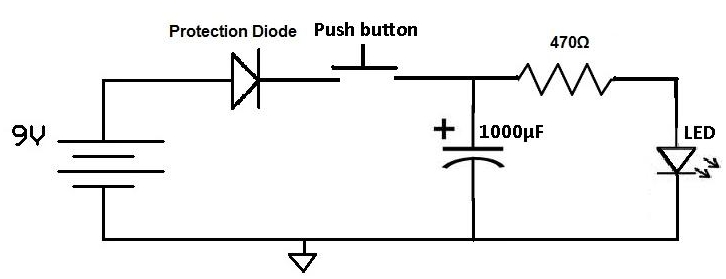With the 9v circuit shown above (I will change to 35v, and a 2k resistor),
(1) when the switched is pressed it will light the led showing charging not when the cap reaches 35v ? or does it gradually get brighter when nearing full charge.
When the 9V power supply charges the 1000 uF capacitor, it will also cause the LED to glow. When the 9V power supply is disconnected the
(2) when the switch is released, will not the led then drain the capacitor and fade out when discharged ?
When the 9V power supply is disconnected, the 1000 uF capacitor will act as the power supply and discharge. Most LED's work at a 2-3 volt range.
Now look at schematic 1.jpg diagram.
There you'll see the original 9V circuit re-draw, with the Zener diode (IN4728, 3.3V) and the push button switch.
(1) When the 9V power supply is connected, it will charge the 1000 uF capacitor.
(2) When the 9V power supply is disconnected, the 1000 uF capacitor will act as the power supply, and if you press the push button switch, it will cause the LED to glow, because the Zener diode is rated at 3.3V and it allows current to flow when The voltage is higher than 3.3V.
(3) When the push button switch is released, the 1000 uF capacitor is isolated and therefore won't discharge.
Voltages measured between 1 & 2 = 2.32V and 2 & 3 = 5.53V
Now, for the 35V circuit.
R = (35/9) x 470 = 1827.8 ohms.
Zener diodes.
IN4751 = 30V
IN4752 = 33V
IN4753 = 35V <=???
IN4761 = 75V
If you need the 1000 uF capacitor within a voltage range of say, 30V - 33V
Red LED with IN4751 = 30V
Green LED with IN4752 = 33V
Finally, look at schematic 2.jpg diagram. An alternative?


Edited by Crazy Cat, 05 September 2014 - 08:35 AM.




















